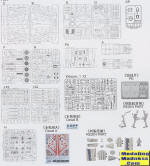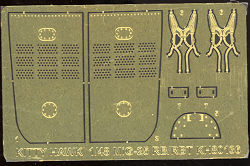
Kitty Hawk 1/48 MiG-25 PU 'Foxbat'
| KIT #: | KH 80136 |
| PRICE: | $109.95 SRP |
| DECALS: | Four options |
| REVIEWER: | Scott Van Aken |
| NOTES: | Includes resin and photo etch parts. |

| HISTORY |
The first prototype flew in 1964, and the aircraft entered service in 1970. It has an operational top speed of Mach 2.83 (Mach 3.2 is possible but at risk of significant damage to the engines) and features a powerful radar and four air-to-air missiles. When first seen in reconnaissance photography, the large wing suggested an enormous and highly maneuverable fighter, at a time when U.S. design theories were also evolving towards higher maneuverability due to combat performance in the Vietnam War. The appearance of the MiG-25 sparked serious concern in the West and prompted dramatic increases in performance for the McDonnell Douglas F-15 Eagle then under development in the late 1960s. The capabilities of the MiG-25 were better understood in 1976 when Soviet pilot Viktor Belenko defected in a MiG-25 to the United States via Japan. It turned out that the aircraft's weight necessitated its large wings.
Production of the MiG-25 series ended in 1984 after completion of 1,190 aircraft. A symbol of the Cold War, the MiG-25 flew with Soviet allies and former Soviet republics, remaining in limited service in several export customers. It is one of the highest-flying military aircraft, one of the fastest serially produced interceptor aircraft, and the second-fastest serially produced aircraft after the SR-71 reconnaissance aircraft that was built in very small series compared to the MiG-25. As of 2018, the MiG-25 remains the fastest manned serially produced aircraft in operational use and the fastest plane that was offered for supersonic flights and edge-of-space flights to civilian customers.
Not surprisingly, the aircraft was built as a dedicated reconnaissance platform. This kit allows you to build the MiG-25RB, which incorporates a bombing system allowing the carriage of 8 500 kg bombs. You can also build the MiG-25RBT, which adds in an ELINT capability. As was the norm with Soviet fast jets, a two seat conversion trainer, which lacks the radar was also developed. It is combat capable, but without the big radar set, is limited in what it can operate.
| THE KIT |
 Not
surprisingly, much of this kit is based on their earlier MiG-25 release and as
expected in the last preview of their MiG kit, it is a two seat version. What
Kitty Hawk has done with this boxing is to provide the complete cockpit in
resin. This includes the seat and a pair of crew members. Apparently it is less
expensive to go that route than to injection mold new sprues. These resin parts
come packaged in their own small plastic case to prevent any issues with damage
in shipping. The photo etch fret includes seat harnesses and you have decals you
can put over the resin detail on the panels and side consoles.
Not
surprisingly, much of this kit is based on their earlier MiG-25 release and as
expected in the last preview of their MiG kit, it is a two seat version. What
Kitty Hawk has done with this boxing is to provide the complete cockpit in
resin. This includes the seat and a pair of crew members. Apparently it is less
expensive to go that route than to injection mold new sprues. These resin parts
come packaged in their own small plastic case to prevent any issues with damage
in shipping. The photo etch fret includes seat harnesses and you have decals you
can put over the resin detail on the panels and side consoles.
As seems to be more and more common, you are asked to build up the nose gear
well, install the gear then trap it and the cockpit in the forward fuselage
section. Once again, I'd recommend test fitting to see if the nose gear can be
installed near the end of the build. Same for the main gear. An unusual step for
any kit maker are resin main and nose landing gear. These are super bly
molded in resin as well. They are quite beefy so I doubt there will be any
issues with resin sag as time goes on. The intakes use a pair of photo etch
pieces for the upper portion of the engine intakes and this section attaches to
the nose.
bly
molded in resin as well. They are quite beefy so I doubt there will be any
issues with resin sag as time goes on. The intakes use a pair of photo etch
pieces for the upper portion of the engine intakes and this section attaches to
the nose.
Building then moves to the complete assembly of the main gear well and landing gear. These are installed in the lower fuselage piece along with the rather complex exhaust. You are provided resin burner cans and rear nozzle covers. One then attaches the upper fuselage piece and after a couple of smaller bits are installed. The nose section goes on, this incorporating the second cockpit. The kit provides a large ball bearing for nose weight, a nice touch. Since the intake doors are closed, there is no need for any trunking detail.
Then one begins attaching flight surfaces. Wings have separate ailerons and flaps with the ailerons shown as drooped. You can also pose the speed brakes extended if you wish.
 A goodly
number of weapons are included with the instructions showing mostly air to
air missiles, though bombs are included on the sprues. As mentioned earlier,
these aircraft do have limited combat capabilities, though I'd check photos on
the web to see of any of them carried any sort of ordnance on the wing pylons.
A goodly
number of weapons are included with the instructions showing mostly air to
air missiles, though bombs are included on the sprues. As mentioned earlier,
these aircraft do have limited combat capabilities, though I'd check photos on
the web to see of any of them carried any sort of ordnance on the wing pylons.
Instructions are well done and provide no cockpit color information at all. I'd use that turquoise color that one sees so frequently on Soviet tactical aircraft. Again, check the web for seat shades. A very nicely done decal sheet provides four markings options. One is the very colorful box art aircraft from the Ukraine, while the rest are basically overall grey. One is Indian Air Force and two others are Russian. You are also provided with a host of missile markings.
| CONCLUSIONS |
This is a nicely done kit. It will build into a rather large aircraft when done and while it may appear at first to be complex, reading through the instructions shows that it will not be any more difficult than any other modern 1/48 jet kit and perhaps even less fiddly. S
September 2019
Copyright ModelingMadness.com. All rights reserved.
Thanks to Kitty Hawk for providing the preview kit. Get yours
at your favorite retailer. If you would like your product reviewed fairly and fairly quickly, please
contact
the editor or see other details in the
Note to
Contributors. Back to the Main Page
Back to the Review
Index Page
Back to the Previews Index Page